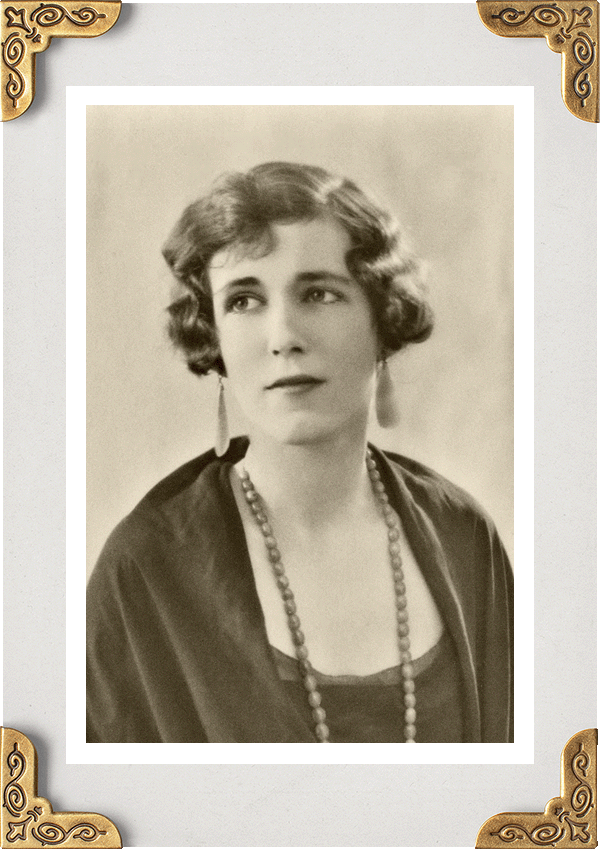About Georgette Heyer

Georgette Heyer was born in 1902 in London. She spent most of her childhood in Wimbledon, though her family lived in Paris for a couple of years before being forced to return to England with the outbreak of WW1. She was the eldest of three children, with two younger brothers. She received very little formal education and was taught at home by her father, George. Heyer enjoyed her position as the “sheltered daughter” which saw her grow up with a slightly Victorian outlook and sensibility. Throughout her life, she was an intensely private person.
“You will find me in my books.”
At the age of 17, Heyer began dreaming up a serial story to entertain and amuse her convalescent brother. Her father encouraged her to write the story down and send it to a publisher and two years later, in 1921, The Black Moth was published, a rollicking historical tale of duels, dukes and highwaymen.
In 1925, Heyer married mining engineer, George Ronald Rougier. Ronald was frequently sent overseas for work, occasionally leaving Heyer at home to write. But Heyer joined her husband to live in Tanganyika for two years and Macedonia for one year, experiences which inspired a handful of her novels and short stories. In 1932, Heyer gave birth to their only son, Richard. Focused and disciplined, Heyer was by now the breadwinner of the family, releasing one romance and one crime thriller novel a year.
Heyer’s early novels had romance at their centre, but in 1935 she published Regency Buck, which established the Regency romance genre for which she would become forever associated. Heyer researched these novels scrupulously to imbue them with the atmosphere of the era. By the time of her death, she had an archive of materials including over 1000 historical reference books. She clipped out information from magazines, noted down vocabulary and facts on note cards, and sorted everything into files under varied and specific category headings: “Beauty, Colours, Dress, Hats, Household, Prices, and Shops.” Such was her attention to detail that she even purchased a letter written by the Duke of Wellington so that she could perfectly capture his writing style in An Infamous Army.
During the Second World War, Heyer and Ronald lived in a little flat in Hove, near Brighton, which was so cramped she wrote Penhallow in notebooks balanced on her knees. In 1942, a year after the Blitz ended in London, the couple were able to move to Albany, a mansion block just off Piccadilly. Their neighbours included writers and celebrities such as Graham Greene, JB Priestley and Gertrude Stein.
Despite her increasing success and fame, Heyer was fiercely opposed to sharing her private life with the public and shunned publicity. She maintained that her readers could learn all they needed to know about her in her books. She made no promotional appearances, only ever gave one interview, and would only answer fan letters if they made an interesting historical point or asked a useful question. She had no time for gushing flattery. In her one interview, with journalist Coral Craig for Australian publication Woman’s Day, she refused to talk about her books and writing, instead discussing, over a dry martini, poetry, history, films and architecture. That Heyer became a bestselling novelist while refusing to promote herself emphasises the captivating power of her storytelling. Her novels sold themselves – and they still do.
Although shy, Heyer had a dry wit and could be intimidating. After attending a private lunch with Queen Elizabeth II at Buckingham Palace, Heyer recounted in a letter that the Queen “kept on stealing sidelong looks at me, & blushing pink whenever I happened to catch her eye.” It is said that a few days later The Queen went to Harrods to buy twelve copies of Heyer’s latest novel Frederica, where she remarked that Heyer was a “formidable woman”.
Heyer was notoriously self-deprecating about herself and her work, once stating:
“I think myself I ought to be shot for writing such nonsense, but it’s unquestionably good escapist literature; & I think I should rather like it if I were sitting in an air-raid shelter, or recovering from flu.”
Georgette Heyer continued writing right up until her death from lung cancer in July 1974. Her final novel, My Lord John, was published posthumously.
